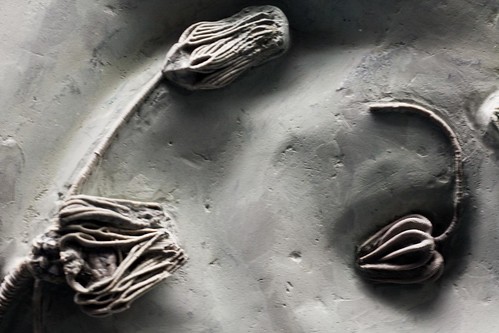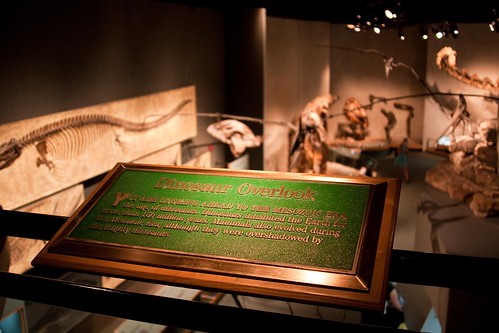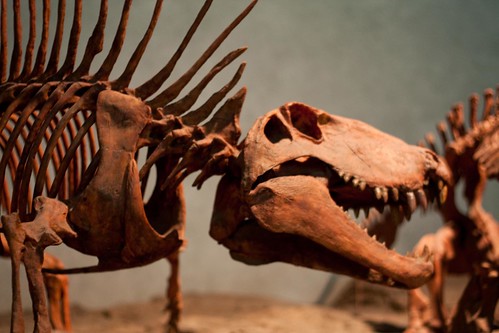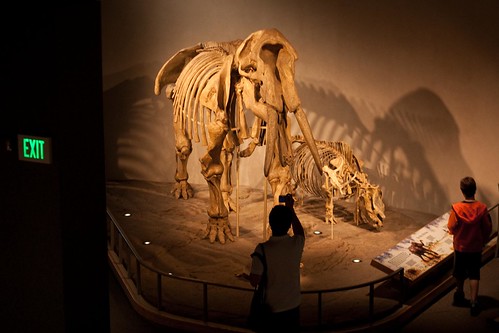(This is Part 3 of my Denver! Who knew? series. Check out the rest here.)
About 19 miles outside of Denver, a mountain ridge is covered with the pitter patter of dinosaur footprints, petrified in prehistoric rock. A friend recently climbed to the summit of a 14,000 ft Colorado peak…only to find a bed of seashells.
Mind blown? Mind. Blown.
The Denver Museum of Nature and Science brings this all wonderfully together in a remarkable exhibit featuring paintings of the Ancient Denvers. Tracking Denver’s progression from a Middle Eastern-style bubbling seafront to an actual sea to the Rockies we know today, the paintings efficiently remind us that our geography is ever-changing and impermanent. (Ancient Denvers is also a book; in case you want to have your mind blown on a daily basis.)
Denver, CO is dinosaur country, and the museum’s award-winning Prehistoric Journey is a reason to visit the museum all in itself. Through two stories of exhibits, you can experience Colorado’s history as a watering hole for stromalites, apatosaurs, triceratops, tyrannosaurus rex, mastodons, woolly mammoths, and eventually humans all at the wonderful Denver Museum of Nature and Science.
The dramatic entryway invites you to learn the History of Life, starting with ever-exciting aquatic single celled organisms. Most children rushed quickly past this part, dragging parents behind them. Which can lead to some key information breakdowns. Down below, I heard a mother bellow, “COME TAKE A PICTURE IN FRONT OF THE DINOSAUR” to her 4 and 7 year olds; she was standing in front of a mammal.
Indeed, you won’t see any dinosaurs until you are roughly halfway through the Prehistoric Journey exhibit, which coincides with their emergence. It took a while to go from aquatic single cell organisms to 50 ton beasts.
The kids have a point, though, the dinosaur hall is clearly the coolest thing in the exhibit. The Denver Museum does a fantastic job of lighting and arraying the specimens in life-like (re: savage) positions. A T-Rex looking Allosaurus plunges at the neck of a Stegosaurus, its baby Stegsosaurus trailing behind. Keeping things local, both skeletons are native Coloradans; the Stegosaurus was found 60 miles southwest of Colorado Springs.
Do you all know about the K-T Boundary? I’m not sure if this was only new to me, but…MIND. BLOWN. And it wasn’t just me. A 4-yr old boy sat staring at the K-T boundary exhibit, his mother looking on in disbelief, “I don’t know. He’s just really in to it. He’s been staring at it for 10 minutes now.”
The K-T boundary is a layer of sediment that is 65 million years old, that exists in rock formations all around the world. Think: rock rock rock rock thin-white-chalky-layer rock rock rock. In Colorado. In Alberta. In New Zealand. Across the entire world.
Towards the end of the exhibit, you’ll walk upon an active, glass-enclosed paleontologist lab that is processing the thousands of bones, and 40 mastodons, found in Snowmass, CO last year. Scientists believe that it may have been an ancient watering hole for Ice Age animals, and that a mysterious event occurred that killed all of them at once. Or as NOVA called it, An Ice Age Death Trap.
If you leave the exhibit feeling slightly heady, slightly mind-altered, and wondering big thoughts on Life, God, and The Meaning Of It All, the Denver Museum is prepared. A retired pastor-turned-museum-docent stands ready to answer and discuss any questions with you.
In addition to the Prehistoric Journey exhibit, another must-see for Denver enthusiasts is the Gems and Minerals collection, including a blue velvet vault of Colorado gold nuggets mined from nearby mountain towns. The rooftop deck also boasts the greatest view in Denver, and they aren’t exaggerating.
—————————————————————————————-
The Denver Museum of Nature and Science
2001 Colorado Boulevard Denver, Colorado
Hours: 9am to 5pm, daily
Admission: Adult $13, Children (3-18) and Students $8, Seniors $10. You can also buy IMAX and Planetarium packages.
How to Get There: From downtown Denver, take bus route 20 or 32. See here for how to ride the Denver buses. The museum has free car and bike parking available.











